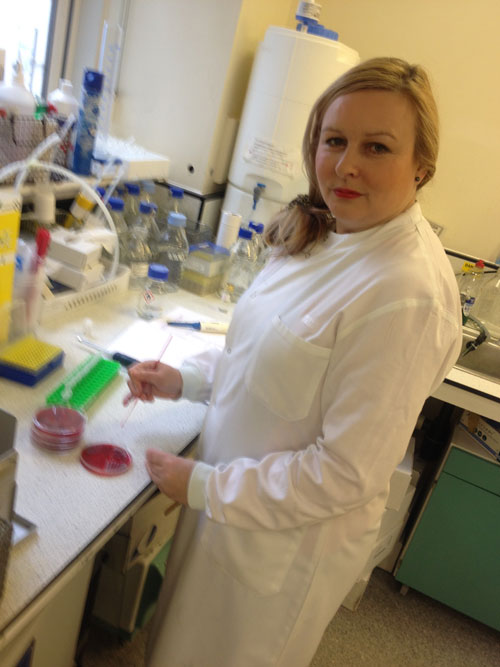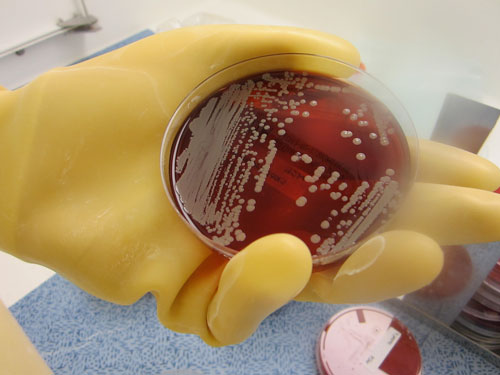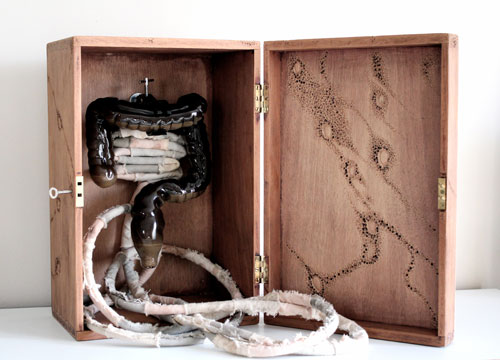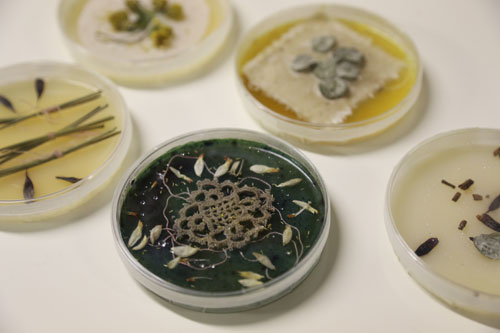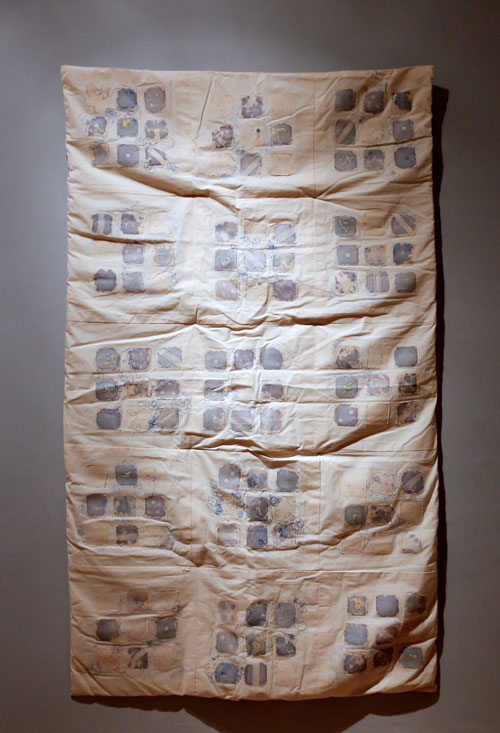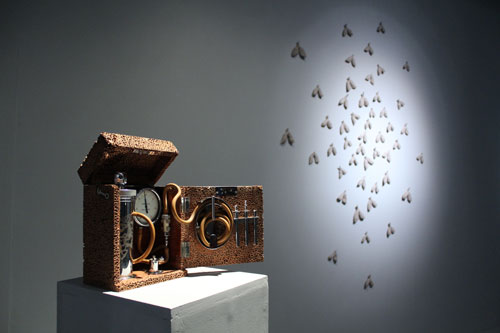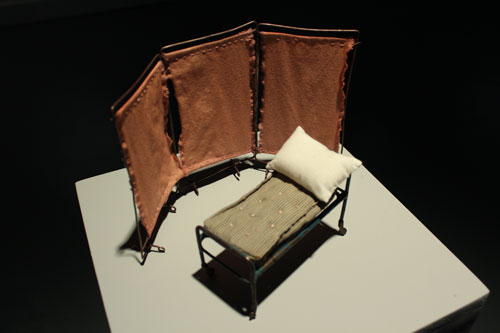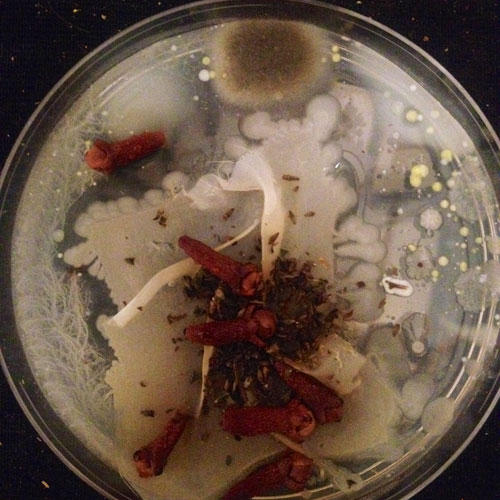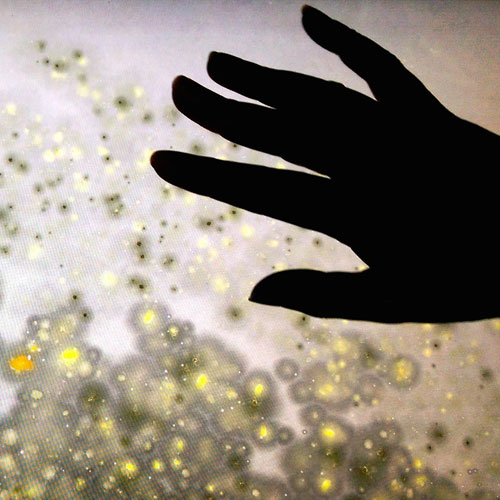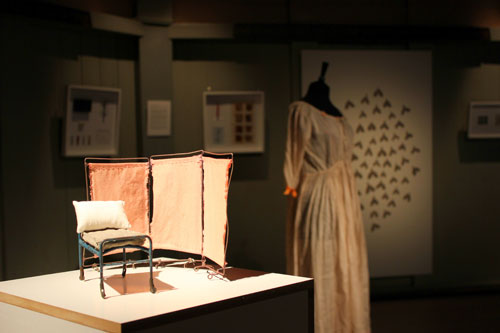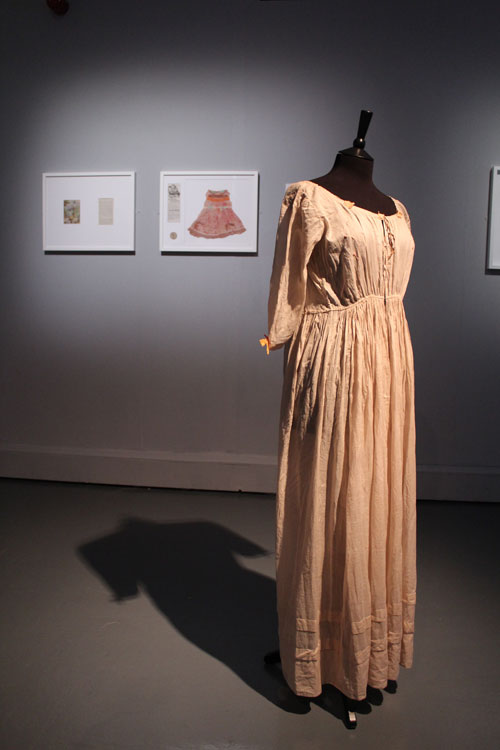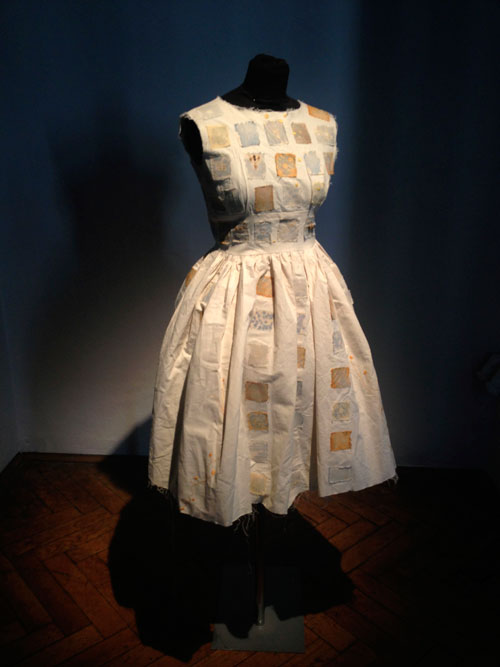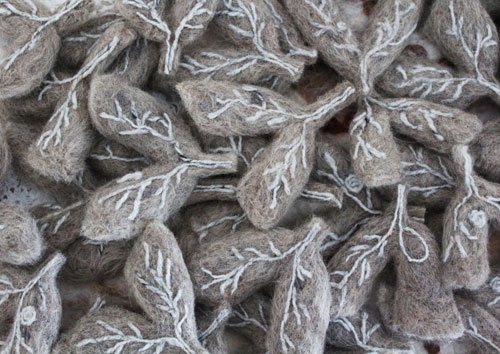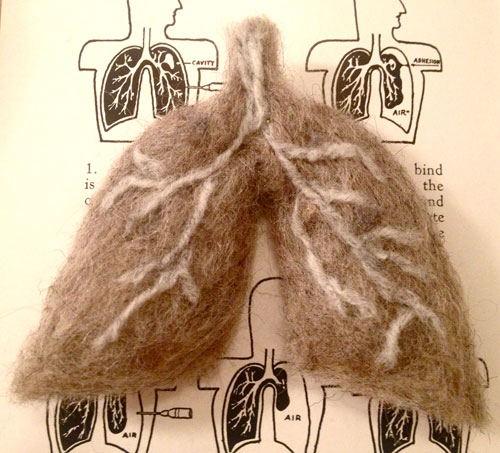

by ANNA McNAY
Anna Dumitriu trained as a painter, gaining a masters in painting from Brighton in 1996. With an interest in bacteria and imagery taken from cell biology, she soon sought out a scientist with whom to collaborate, and learned to handle bacteria – including tuberculosis and methicillin-resistant staphylococcus aureus (MRSA). Now with almost 15 years’ experience, she is widely respected within the microbiology sphere as one of the team, despite never undergoing any formal training. Her art projects set out to explore and tell stories, to raise questions and to bring the general public into dialogue with scientists and medical professionals about issues that increasingly affect them, but which are often shrouded in mystery – and myth.
Two of Dumitriu’s works have recently been added to the Eden Project’s new permanent exhibition, Invisible You: The Human Microbiome. Studio International spoke to her about what it is like to work on the crossover of science and art.
Anna McNay: You come from a background in painting. Can you explain how you got from there to where you are now, working in labs with microbiologists, using bacteria as your medium?
Anna Dumitriu: I was always interested in those sorts of themes in the subject matter of my paintings. They were quite abstract. I did a lot with textures and images of cell biology. The kind of work I do is actually more normal nowadays. It was really unusual back then. I was interested in working with a scientist and so I sought one out.
It’s a bit of a long story. I was doing some research online – it was when you could first get on the internet properly – and I was looking up information about E coli bacteria, which, as far as I knew, caused a nasty kind of food poisoning. I didn’t realise that a lot of our gut bacteria are E coli and they help us digest our food. You always hear negative stories, such as “two people died of an E coli outbreak”, but you never hear about the billions of people who digested their dinner and gained nutrients from their meals through metabolising it with E coli bacteria. I became very interested in the stories behind the stories and, looking critically at the media stories around science, I became particularly interested in microbiology – specifically bacteria.
Bacteria are living organisms that you can work with – almost in a painterly kind of way. They’re like an artistic medium. I use cotton calico a lot, which is used for painting, too, and I apply the bacteria to the material, embedded in petri dishes, and then I add antibiotics to control where the bacteria will grow. By doing this, you can create patterns in the textile. I use dyes that are usually used for diagnostic tests and they cause certain bacteria to grow in certain colours.
The more you look into bacteria, the weirder the stories are. The Brighton and Sussex Medical School had just opened at the time and so I wrote an email saying what I was interested in doing – learning about bacteria and mapping them in my house. The television show How Clean Is Your House? was popular at the time. They were always saying things like: “Oh, this is dirt. You’ve got dirt in your house!” and showing a petri dish to someone. Actually, every surface in the world is covered with bacteria, so, rather than “How clean is your house?”, I was more interested in “How sublime is your ecosystem?”.
All bacteria are communicating with each other using chemical signalling. They know how many of their species and how many of other species there are. It’s very much like the internet with nodes firing off signals. They can do headcounts and even coordinate their behaviour as a group. So we’re in this huge networked system and there are more bacterial cells in the human body than there are human cells. They say it’s 10 times more but that’s not proven – it’s just one of those facts someone pulled out of the air once. But they are all communicating and they can communicate with our human cells as well. Gut bacteria cells control how the lining of your gut is shaped, things like that.
The more you look into it, the weirder it gets. It’s almost a spiritual thing. Freud called it “oceanic feeling” – this idea of being so interconnected, which he said was a failure to detach from the oral phase. But this sort of feeling of spirituality that non-religious people can feel is inherent in the microbiological world. Anyway, I’m not going down that mad spiritual route! But all those things were sort of rattling around in my mind at the time. So I wrote to the medical school and I got an email back from the professor of primary care, Helen Smith, who is an expert in allergy. She really liked my work and wanted to do my project, so we got some funding from the Wellcome Trust and did a great project, where we took over a school and worked with a group of students to investigate allergy and the impact of that on young people’s lives. We turned the school into a kind of performative installation for one night. After that, I was introduced to a microbiologist, Dr John Paul, and we have been collaborating for about 12 years now. When we began collaborating, he was a consultant microbiologist, but now he’s lead public health microbiologist for the south-east region. He’s also a co-applicant on a major research project called Modernising Medical Microbiology at Oxford University, so I got appointed through him as the artist in residence on that project.
Working so much hands-on in the lab opens a lot of doors. Other people see my work and let me join them in their labs, so I learn other techniques. I’m always learning new stuff and pushing my boundaries. For the most recent work, I’m doing, I had to have a typhoid vaccination. I’ve been able to experience working with plague and anthrax. I’ve done some work around the concept of a “bacterial sublime” – a sense of the sublime from the power, awe, complexity, fear and terror, but also the beauty. I think that things such as the plague and tuberculosis have that quality because they are terrifying. Those sorts of things really fascinate me, so I wanted to put myself in that position of being close to these organisms.
AMc: Does all of your work have to be made in the lab environment?
AD: No. I use do-it-yourself microbiology processes as well, so I can work in my studio and grow bacteria. But I don't work with pathogenic bacteria in my studio.
AMc: When you’re working in the lab, are the bacteria still alive?
AD: Yes.
AMc: But, presumably, when you take the work out to display it somewhere, they’re no longer alive?
AD: That’s right. I use a high-pressure steam sterilisation technique called autoclaving. I don't know if you saw the little lungs I made?
AMc: Yes – as part of your TB project?
AD: That’s right. They’re impregnated with the extracted DNA of TB. You can’t grow TB from it – it’s a validated kill protocol. Modernising Medical Microbiology developed it in order to be able to work on TB DNA outside a category-three lab [laboratory safety ratings go from one to four, with four being the highest level].
AMc: You’ve worked a lot with TB. You’ve done a whole big project and you’ve worked together with the Target Tuberculosis charity, donating some of your proceeds to them. You also spoke to a lot of people and found out some unbelievable myths and misinformation about the disease.
AD: The charity did the research for me in the field. I met them when they got back and we discussed things such as why people think they’ve got TB and what the issues are in communicating it. In 1902, in England, they thought dust was the primary cause. They thought that people would spit and their spit would dry and then you’d sweep it up and breathe in the dust and you’d get TB. But you can’t catch it like that. It needs to be aerosolised, so you need to be coughed on to catch it. But it’s not viable as dust.
Anyway, I was interested in all those sorts of myths and how ideas about health are constructed. In Uganda, they found hugely diverse stories as to why people thought they’d got it, which ranged from eating unripe mangoes to being licked by a cat. We then used some of the things that were said in the workshop that we ran as part of the project. We worked with environmental mycobacteria, which are biosafety level-one organisms, and we tried to see if they would grow better in the presence of an unripe mango or with some cat hair. I worked in collaboration with two scientists on that workshop because it was pushing the limits of what you can do in a public setting.
AMc: Who takes part in these workshops? Are they open to the general public?
AD: Yes. With that one, I said it was for artists, scientists and anyone who was really interested. It ran for five Saturdays, so it was quite a long one. But a lot of my workshops are just drop-in and you get really random passersby joining in. I did some workshops at the Eden Project this summer, making infected textiles, and sometimes you’d get parents with little children and they’d say: “Go and have a go!” And then I’d say: “It’s for all ages!” So I’d get the parents to sit down as well. Then they start asking questions and you can have a really interesting discussion. One time, I had a group of maybe 10 older people come and sit down and they took over the whole thing. They had a really fascinating debate because they were really interested in hospital-acquired infections – what people are doing about them, whether they should be worried about what they had heard.
When I do the workshops, I often use things that people think are antimicrobial, or that are, in fact, antimicrobial. Natural things. This happens a lot in drug discovery: they’re always testing natural substances and trying to find out what has an effect. Recently, I think, there has been new research around an old Italian remedy for infections, which is a kind of tea made from sweet-chestnut leaves, and they just found that one of the molecules in this inhibits toxin production in MRSA, so that might become a new drug. I’m working with another scientist at Brighton and Sussex Medical School who has got a molecule extracted from a Brazilian plant, which kills TB, and she’s trying to work out if it will work in the human body. Then there are things such as turmeric, garlic, madder root – a lot of different things – and I’m always on the lookout for new things. Sometimes I collect the leaves or some powder and we use these in my workshops. The beauty of doing it at Eden was that the gardeners went and got plants from the garden there. It is full of medicinal plants and they have a dye garden, too, so they brought me the actual leaves and we were able to stitch them on to the material.
I usually have antique crochet, from secondhand markets, or linen. Linen itself is actually made using bacteria. The first step of the linen production process involves rotting down the flax using bacteria – it’s a kind of fermentation thing, known as retting – so I like to work with that. It also references women and their role in science and the fact that, at the time of the Enlightenment, the highest level of achievement for a woman was considered (by the philosopher Rousseau) to be a proficiency in white-work embroidery – a very fine kind of white on white embroidery. So I use a lot of antique embroideries and antique crochets and we cut them up and repurpose them into the works. Then participants get to work with the plant leaves and they do their own experiments and then I allow them to grow, take photographs and put them online.
I did a workshop at the Victoria and Albert Museum in London where we used Staphylococcus aureus plates with a special dye on them so that when the Staphylococcus aureus bacteria grow, they grow blue. Although the bacteria live on about 30% of us, Staphylococcus aureus is considered to be a pathogen [something that causes disease] – it’s a biosafety level-two organism. So it’s quite interesting for people to see if they grow it on their samples. Everyone got to make a quilt square and lay it into a petri dish and then we took them away to the lab, incubated them at 37C, and put all the photographs of the results online. I then used these pieces to make another work.
AMc: So it’s all an ongoing process?
AD: Yes. People are contributing to future pieces, which they seem to like.
AMc: Do you feel any responsibility that your work is educational in some aspect?
AD: At Eden, I had an older couple come and sit down and I was explaining about the piece, which is about faecal transplants and Clostridium difficile, and they said that their daughter had just been diagnosed with it. So quite often we got those sorts of situations, where people come and ask me and my colleagues about things that are affecting them. You have to handle it quite carefully. I’ve been working in the area for a long time and I work with a lot of medics, so hopefully we’re handling it in the right way and giving people the right information, but it’s nice for them to be able to have a place to ask questions as well.
The issue of infectious disease is so important. It’s almost been forgotten how important it is because of the age of antibiotics. We all think everything’s solved and that if you get an illness you get antibiotics and you get better. But we’re coming to a stage where there is so much drug-resistance and so few new drugs being developed, that we might be at a point soon where we almost go back to a pre-antibiotic era. They’re working very hard to avoid this, so don't panic yet! But we need to be very careful about how we handle the issue of antibiotic resistance. Mine is a kind of activist art, partly. But it’s a visceral and aesthetic experience, too, and I don't think it would work if it were just teaching. I prefer the idea that it is a vehicle for storytelling or a space for engagement. There are lots of different levels, I guess.
AMc: Do you ever meet with resistance from the audience or people suggesting that you shouldn’t be doing what you are, or that you’re playing with dangerous things?
AD: Not a huge amount because I’m always very clear from the outset about what background I’m coming from.
AMc: Can you talk a bit about your two works at the Eden Project? You’ve mentioned the workshop, but tell me about the actual works.
AD: Well, one is called Don’t Try This at Home and it is about the procedure of human faecal transplant. I worked with Dr Jane Freeman and Dr Caroline Chilton from the Healthcare Associated Infection Research Group at the University of Leeds. The transplant involves taking bacteria from a healthy person’s gut and giving it to someone who is ill. They do clinical screening and a health questionnaire first to make sure that it’s good, and it’s usually taken from a family member or friend. A lot of gut bacteria are what are called anaerobic: they hate oxygen. So they take the faecal sample and it is stored in a special sachet so that it doesn’t get exposed to the air. It gets taken quite quickly to the lab, where it’s prepared. Basically, you have to add liquid to it, mush it up in a machine called a stomacher, and strain it through something like the muslin they use for straining beer in home brewing.
This was pushing a boundary for me because, to be honest, I never thought I would start working with gut bacteria – it’s a little bit disgusting! But the issue of Clostridium difficile is fascinating and the scientists kind of kidnapped me! I was invited to give a talk at the University of Leeds and they asked if I’d like to see their gut model. Now, I’ve done quite a bit of work with scientists on the computer modelling side and when they said “gut model”, I thought: “Oh, gosh, it’s going to be one of those computer models with a horrible screen with some little dots on it or something.” I thought it was going to be really boring. But then they took me to see it and it was a room full of bubbling jars with pink liquid being fed in. The jars and chambers represented the different parts of the gut. Basically, C diff is an opportunistic organism, which can completely take over. People who have very long-term C diff infections have no quality of life – they’re really ill. You can cure it using antibiotics, but it’s very hard. It can go into a dormant seed state and hide in the lining of the gut, so you get this process of reinfection all the time. But what they’ve discovered is that, in around 90% of cases, after a maximum of two treatments, faecal transplants appear to completely cure it.
The reason why I call the piece Don't Try This at Home is because there’s apparently a massive vogue for self-performing these transplants. A man from the US went to Tanzania and got a faecal sample from the most isolated tribe in the world and gave himself a transplant with it because he thought that was the most natural gut microbiota possible. It’s the most natural gut microbiota for them, exposed as they are to certain parasites, diet, etc, but there’s no such thing as a natural gut microbiota. I mean, it’s best to avoid taking antibiotics. They should only be a last-ditch thing really because it takes two years or so for your gut to recover after a course of antibiotics and you never have the same diversity again.
There’s a history of artists working with this medium – faeces – but I think I’m coming at it from a very different angle. Also, I don’t think there have been many women artists working with it before, as far as I know. I’m still very aware that there is a disgust response, but I hope that the object has a kind of beauty to it as well. Basically, there’s a glass colon, filled with a human faecal transplant, which has been sterilised. It has to be sterilised because otherwise it would continue to ferment and then it would explode in the gallery. It’s in a case carved with images of the C diff spores as they form biofilms in the gut and there is an intestine made from cotton calico stained with various types of gut bacteria.
AMc: Do the samples smell?
AD: Yes, but not that bad. I mean, unhealthy and healthy, you can tell the difference, I think. The scientists are always saying things like: “Oh, well, I knew that one wasn’t going to take because it didn’t smell right.” When I first visited them, we ended up having a bacteria sniffing session and they taught me to identify different gut bacteria from the smell. Clostridium difficile actually smells a lot like farmyards. Sometimes I’m walking along and I’ll say: “Oh, it smells a bit C diff here!” I think you get used to it as well because my partner – I get him to come and film sometimes – doesn’t like coming into the microbiology lab and says it smells. It’s mostly the agar – the boiled seaweed they use to grow bacteria – because that has quite a strong, distinctive smell. It’s not unpleasant though – if you’re used to it. I’m like: “Ah, microbiology!” I used to be like that with really strong oil-paint smells. It’s not a pleasant smell exactly but, if you’re into that sort of thing, it’s quite a comforting smell.
AMc: Does carrying out this kind of work make you more alert to everyday hygiene issues?
AD: Not in an obsessive compulsive-type way. I sometimes say to people, “I wouldn’t do that, if I were you!” or “I wouldn’t eat that if I were you!”
AMc: No raw mangoes!
AD: Yeah! Don’t get licked by a cat! But no, I’m not really worried about that sort of thing. We’ve all got quite strong immune systems and we’re all fine and healthy in our everyday environment.
AMc: Your second piece of work at the Eden Project, The Human Super-Organism, is about making people aware of, or revealing, the bacteria that live on our hands.
AD: Yes.I’ve done a few different versions of it with Alex May, my partner. We set up a dark space in our sitting room and did some do-it-yourself microbiology. We grew bacteria from our own bodies and took some high-definition time-lapsephotography of it. This isn’t straightforward because you have to play with the depth and wetness of the agar to get it to last, and then Alex had to write some software so it would track where the bacterial colonies were. If you’re cutting out tiny colonies from an image, they move, so this is something that a lot of scientists have never managed to achieve. So, we’ve got this really lovely high-definition footage of these colonies growing in time-lapse and then we cut them out digitally and they became part of the digital library.
We did one that was a full body version. There’s a camera behind the screen and an infrared light sensor in front of the screen. When you press against the screen, you block the light coming through to the camera, so the camera knows exactly where you are and then fills your body shape with the bacteria growing, as if you were a little person being pressed into a petri dish.
For the version at Eden, we used a Leap Motion sensor, which senses the position of your fingers and hands on the screen. People think it’s a touchscreen, but it’s not, as they aren’t precise enough. You put your hands on the screen and then, when you lift them off, the bacteria grow as if the screen were a big petri dish full of agar. We sped it up because, if they took three days to grow, that would be boring. They take about 20 seconds to grow. Then it goes back to a clean screen so the next person can come and have a go.
People seemed to be fascinated by this. Of course, we don't tell them it’s not their body, although, logically, you’d know. But they think that this is the bacteria from their hands and, because we use a Perlin noise generator to randomise the growth, and because it also depends on how you put your hands on the screen and how quickly you take them away again, some people look as if they’ve grown more bacteria than others. That always leads to comments like: “Oh, you’re so disgusting!”
AMc: Does all your funding now come from scientific bodies rather than the Arts Council?
AD: No, not at all. The Sequence Project, which is my current project, is funded by Arts Council England.
AMc: Is the work you make affected by where the funding comes from?
AD: Not really. It affects how I write the grant, but it doesn’t really affect what I do. The funding from scientific bodies is not really science funding, anyhow; it’s funding for doing science engagement or communication, it usually comes from the perspective of wanting people to think about science in new ways or think about bringing different audiences to science. It’s the same thing with the Arts Council, which wants you to bring new audiences to art. Every piece gets shown in both contexts. It’s just a question of which outcomes you put down on the funding proposal. It’s this complete blurring of the boundaries, I think.
AMc: Do you think there should be more cross-disciplinary work being made between scientists and artists?
AD: I think there is quite a bit, actually. What I do think is that, rather than there being these short-term collaborations, where an artist is given a sum of money to work with a scientist for two months and produce a piece of work, there should be more long-term embedded residencies, where the artist can really develop an expertise in the field. I’ve been doing this for 13 years now, so, when I come in, I’m coming in with a completely different kind of perspective – they usually treat me as if I’m a microbiologist, but with this creative stuff that they have to get their heads round as well. If you don't know anything about the science, however, you’re going to spend more than two months just trying to learn it and you won’t get very far with anything else.
AMc: Do you ever come up against any ethical issues?
AD: Yes, all the time. I did a project called Trust Me, I’m an Artist which was looking at the ethics of art/science collaboration. I wrote a book on it and we’ve got funding to take the project further. Basically, an artist presents their work to an ethics committee that we set up, based on whatever kind of ethical query they have in whichever country they’re working in, and we interrogate it in front of an audience. Then the audience, the artists and the ethics committee have a big debate about it. It’s like throwing open the doors to what’s normally hidden.
I’m fascinated by that side of things, and I definitely don't want to do things that would be of any risk to the public or researchers. Of course, there are such things as lab accidents, but they’re pretty rare and most are pretty minimal – you just need to have a wash. Things could happen, but there’s no more risk really than crossing the road – less risk, probably. With Public Health England, it’s always a running joke: they never say anything is risk-free. They’ll say: “He will walk across the room. It’s a low-risk activity but it’s not a no-risk activity.” Even if I’m going to stay sitting here at my desk: “Well, what if the chair collapses? It’s a low-risk activity! What if the computer explodes?” So if someone says: “No, you can’t do that,” as a knee-jerk reaction I will say: “Why not?” Then I will try to solve the problem, or ask: “How would you do it?” That gets them thinking and then they become involved and a bit invested, so then we make the work how they’re happy with it. I’m trying to engage with the staff and the process is important. The important thing is I’m trying to tell the story.
• Anna Dumitriu will be showing Sequence at the London Design Festival: Digital Design Weekend at the Victoria and Albert Museum, 26-27 September 2015, and as part of the Networked Bodies Festival at Watermans Art Centre, Brentford, London, 3-16 November 2015.The Sequence Dress will feature in the exhibition Data Body as Artifact as part of ISMAR 2015 at Fukuoka City Museum, Fukuoka, Japan, 29 September – 3 October 2015.
• Communicating Bacteria will be shown at ZKM | Center for Art and Media, Karlsruhe, Germany, as part of the exhibition GLOBALE: Exo-Evolution, 31 October 2015 – 28 February 2016.
• Some pieces of Bed Flora, Infective Textiles, the MRSA Quilt and Super-organism: The Human Microbiome will be part of the BioCon Art Project in Korea in November 2015.
• See Anna Dumitriu’s work at normalflora.co.uk
